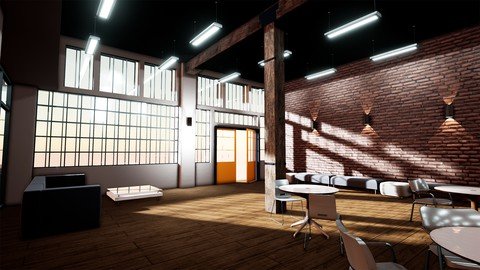
Genre: eLearning | MP4 | Video: h264, 1280×720 | Audio: AAC, 44.1 KHz
Language: English | Size: 6.81 GB | Duration: 6h 18m
Improve your Architectural Visualization skills with this 4 in 1 Unreal Engine course pack
What you’ll learn
Preparing your Revit model for export
Using Unreal Datasmith Product Viewer Tools
Creating Unreal materials
Swapping out materials
Lighting your models
Adding interactions
Packaging content for distribution on VR and mobile devices
Migrating material packages
Batch replacing of materials
Static vs. dynamic lighting
Lightmap analysis, correction, and padding
Shader analysis and correction
Draw call optimization
Improving reflections
Creating a substance graph
Stone, gold, and copper material
Combining materials using an ID mask
Exposing parameters and preparing resolution
Exporting Substance materials
Building a scene
Substance with displacement
Geometry detail vs. texture detail
Advantages of bitmaps in Unreal
Building materials inside Unreal
How and when to use the Material Editor
Building flexibility into materials
Using Substance Source and Share
Using B2M inside Unreal Engine
Benefits of procedural texturing
Description
NOTICE:
When you enrol to this course, you are guaranteed to get one of our other premium courses for a discounted price of 10$. If you are ready notify us through the email provided in the Bonus Lecture at the end of the course!
1- Revit to Unreal for Architecture, Visualization and VR
Intermediate
Section 1 – 7
Revit, 3ds Max, and Unreal are major players in the architecture, visualization, and virtual reality worlds. These technologies allow you to immerse yourself in designs—before you ever build them. Find out how to make these tools play well together to bring your own models to life. Instructor Simon Manning shows how to prepare your Revit projects for export, import them in Unreal, and use the Datasmith Product Viewer template to leverage prebuilt interactive elements such as furniture and lights. Then find out how to create and apply custom materials and adjust the lighting of your model. Simon also shows how to add interactions with Blueprint scripting and package your visualizations for display on VR headsets or mobile devices. Using these tutorials, you can polish your Revit models into interactive presentations that you can’t wait to share with clients.
2- Unreal Engine: ArchViz Design Techniques
Intermediate
Section 8 – 11
Want to work faster and smarter in Unreal Engine? In this course, pick up practical architectural visualization techniques that can help you build compelling experiences with Unreal Engine. Instructor Simon Manning shares tips for working with materials, including how to get realistic mirrors in your scene and give your glass materials reflectivity. He also explores how to regenerate improved lightmaps from within Unreal, as well as how to reduce draw calls and poly counts, measure project performance, and more.
3- Unreal: Substance Designer Workflow
Intermediate
Section 12 – 16
Explore the integration of Substance Designer—a powerful tool for creating textures for 3D art, visualization projects, and games—with Unreal Engine. This course provides a solid foundation of the principles of texture creation in Substance Designer for use in Unreal Engine. Instructor Scott Pagano explains how to import a model into Substance Designer and bake AO, curvature, and ID maps. He discusses the advantages of system-based procedural texture creation, and shows how to create both image file output and substances which can be used and modified directly in the Unreal editor.
4- Unreal Engine: Materials for Architectural Visualization
Intermediate
Section 17 – 23
Learn how to create and optimize materials for architectural visualization in Unreal Engine. In this course, join instructor Joel Bradley as he explores the benefits and drawbacks of some of the most popular visualization workflows, sharing techniques that can help you make your projects look their best. Learn all about the Unreal Material Editor, including how and when to use it. See how to build a base material with the Material Editor that you can reuse on your projects when needed. Plus, discover how to save time by leveraging resources in Substance Source and Substance Share; how to put the Bitmap2Material (B2M) application to good use; and how to create textures procedurally.
Who this course is for:
Intermediate Unreal Engine Users
Password/解压密码www.tbtos.com
转载请注明:0daytown » Unreal Engine : Architectural Visualization